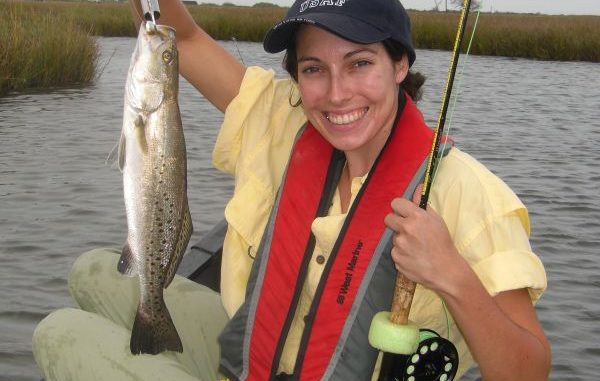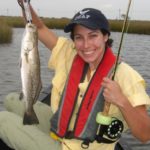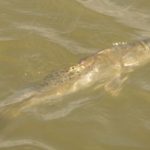
Cool weather brings speck-tacular fly fishing
The Spottail Elvis is much deserving of his reputation as the premier fly-fishing species in our state. He loves to feed in shallow water, where he can be sight fished. He makes fabulous runs when hooked. And he gets big enough to pull a kayak or canoe around.
Redfish are not picky — they’ll eat a wide variety of flies. A red hitting a popper might be the most exciting thing you’ll ever witness.
Best of all, they’re dependable. Reds can tolerant a wide range of temperatures and salinity, and can be found in almost any coastal water, small or large, year round.
Little wonder that an overwhelming number of fly flingers dedicate their efforts to chasing redfish.
Then there are a few like myself who prefer fly fishing for speckled trout. And even for their less-heralded cousins, the white trout.
When asked, I could never explain why. My daughter provided the answer.
Cokie prefers fishing for any species with “trout” in its name, from coldwater types like rainbows and browns to the “green” variety in warmer waters and specks in saltwater.
Her explanation was that redfishing is like hunting — you prowl the shorelines looking for fish, and in doing so, staying on high alert and using energy.
Fishing for speckled trout often involves anchoring up, casting out, and waiting for a bite. A lot less like hunting, but also a lot less like work.
Maybe as I get older, I’m less inclined to work for my fish!
What I do know is that from October through December one certainly doesn’t have to work hard to catch specks on the fly. All you need is a 6-, 7- or 8-weight rod, about an 8-foot leader with at least 2 feet of 12-pound tippet (preferably fluorocarbon), a few clouser minnows or weighted shrimp patterns, and a VOSI.
Frequent readers of this column are familiar with the Vertically Oriented Strike Indicator. Just a fancy name for a perch float cut in half, with the larger end given a concave face (usually by sanding with a Dremel cone bit). It’s the fly rodders’ popping cork. Something I conceived over two decades ago.
The VOSI is placed on the leader, with the concave side of the VOSI facing the fly line and the cork peg inserted on the back end facing the fly. Popping the VOSI with the fly underneath is like ringing the dinner bell for speckled trout.
The VOSI/clouser combination works great on schooling fish up to 3 pounds. But for larger fish, it’s not the answer.
A glance at the Louisiana Outdoor Writers Association top 10 Fly Fish Division listing for spotted seatrout reveals that most of the record fish — ranging from 6.75 pounds to 9.31 pounds — were caught in the period of October to February.
One name found on four of the records is the late Dave Coignet. Dave introduced me to a technique he used for big trout: After a strong cold front, find a hole and — using a sinking line — cast a large, dark baitfish pattern and retrieve the lure very slowly.
Another name on that list is Capt. Jeff Poe of Big Lake Guide Service. Jeff is not only an excellent fly caster and tier, but he’s also one of the few guides in Louisiana who targets speckled trout on the fly.
And he caught the 9.31-pounder that tops the state fly-rod record list.
Back in August, Poe was a guest speaker at the Contraband Fly Casters Expo in Lake Charles. Each year, he catches several trout over 4 pounds on flies. And while some are caught on heavily-weighted clousers worked off the bottom, most of his big fish come on topwaters like Pete’s Popper and sliders like the Dahlberg Diver.
Poe observed that fly anglers get frustrated fishing for specks, in part, because it involves a lot of blind casting. He offered several tips for improving success.
First, use your casting tackle to locate schools. During an eight-hour day, a fly caster might make 500 or more casts, which can lead to fatigue and mistakes. When you find the school, then break out the fly rod. This technique of “lure and switch” is highly effective.
When working the fly (stripping line in), Poe is adamant about keeping the rod tip near the water to eliminate slack. Big specks have a very subtle strike that often goes undetected if there’s even a couple of inches of slack in the line.
Another problem he sees with most fly casters is that they spend too much time false casting and not enough time with the lure in the water. Adding to that, he observes that adding distance to your cast — even just 20 feet — can make a significant difference. In the course of a day, that extra distance can add up to a mile of water!
One look in Poe’s fly box tells you another secret of his success. Nearly all the flies are tied on 2/0 and 3/0 hooks — about twice the size of most trout flies you see in the average saltwater box. Bigger flies do catch bigger fish!
Whether you’re out for schoolies for the family fish fry or a lunker trout for a bragging photo then subsequent release, the peak season is at hand.
Let the Spottail Elvis have a vacation every now and then, and enjoy Louisiana’s other great fly rod fish.




